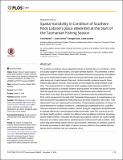Files in this item
Spatial variability in condition of southern rock lobsters (Jasus edwardsii) at the start of the Tasmanian fishing season
Item metadata
| dc.contributor.author | Mendo, Tania | |
| dc.contributor.author | Simon, Cedric | |
| dc.contributor.author | Green, Bridget | |
| dc.contributor.author | Gardner, Caleb | |
| dc.date.accessioned | 2016-12-14T16:30:21Z | |
| dc.date.available | 2016-12-14T16:30:21Z | |
| dc.date.issued | 2016-11-15 | |
| dc.identifier | 248186860 | |
| dc.identifier | 61f6454f-bfe2-485d-818a-ef83ea6d001c | |
| dc.identifier | 84995470004 | |
| dc.identifier | 000387794600047 | |
| dc.identifier.citation | Mendo , T , Simon , C , Green , B & Gardner , C 2016 , ' Spatial variability in condition of southern rock lobsters ( Jasus edwardsii ) at the start of the Tasmanian fishing season ' , PLoS ONE , vol. 11 , no. 11 , e0166343 . https://doi.org/10.1371/journal.pone.0166343 | en |
| dc.identifier.issn | 1932-6203 | |
| dc.identifier.other | ORCID: /0000-0003-4397-2064/work/148888372 | |
| dc.identifier.uri | https://hdl.handle.net/10023/9973 | |
| dc.description | This research was funded by the Australian Seafood Cooperative Research Centre and the Fisheries Research and Development Corporation (project number 2014/726) (http://www.seafoodcrc.com/) (http://frdc.com.au/Pages/home.aspx). The Australian Research Council's Industrial Transformation Research Program (project number IH120100032) is gratefully acknowledged for providing further financial support for two authors to present this work at the Crustacean Society and International Association of Astacology Mid-year Meeting, 19-23 July 2015 (http://www.arc.gov.au/industrial-transformation-research-programme). | en |
| dc.description.abstract | The southern rock lobster (Jasus edwardsii) industry in Australia favours red lobsters, which are usually caught in shallow waters, over paler (brindle) lobsters. This preference is driven partly by the Chinese market, where red is associated with luck and prosperity, and additionally, by the widely held perception within the industry that brindles have greater mortality rates during out of water transport than reds. Limited scientific evidence supports these industry observations; however, these studies did not evaluate the initial condition of lobsters. This study aimed first, to determine which variables better describe condition in J. edwardsii and second, to compare condition among lobsters in several sites around Tasmania at the typical time of high transport mortality. Male lobsters were collected from the South West, South East, East and North coast of Tasmania in late November/December 2014, which correspond to the start of the Tasmanian fishing season. A comprehensive condition assessment was applied by measuring tissue proximal composition, Brix index, Total Haemocyte Count, pH, haemocyanin and another 16 haemolymph parameters of interest. A useful framework to compare condition in J. edwardsii was established by first, using Brix index as a measure of nutritional condition, second, using pH, magnesium, and bicarbonate to evaluate differences in physiological condition and finally, using THC counts as a proxy for lobster health condition. Lobsters from different sites had different nutritional, physiological and health condition, consistent with industry observations, however our results indicate that some red shallow water lobsters exhibited poorer nutritional and health condition, while some deep water brindle lobsters were in good condition. Differences in condition could not be directly associated to catch depth of lobsters and was related to other spatially discrete factors which sometimes vary over distances <3 km. | |
| dc.format.extent | 15 | |
| dc.format.extent | 1468943 | |
| dc.language.iso | eng | |
| dc.relation.ispartof | PLoS ONE | en |
| dc.subject | QH301 Biology | en |
| dc.subject | Medicine(all) | en |
| dc.subject | Biochemistry, Genetics and Molecular Biology(all) | en |
| dc.subject | Agricultural and Biological Sciences(all) | en |
| dc.subject | NDAS | en |
| dc.subject.lcc | QH301 | en |
| dc.title | Spatial variability in condition of southern rock lobsters (Jasus edwardsii) at the start of the Tasmanian fishing season | en |
| dc.type | Journal article | en |
| dc.contributor.institution | University of St Andrews. School of Biology | en |
| dc.contributor.institution | University of St Andrews. Scottish Oceans Institute | en |
| dc.identifier.doi | 10.1371/journal.pone.0166343 | |
| dc.description.status | Peer reviewed | en |
This item appears in the following Collection(s)
Items in the St Andrews Research Repository are protected by copyright, with all rights reserved, unless otherwise indicated.

